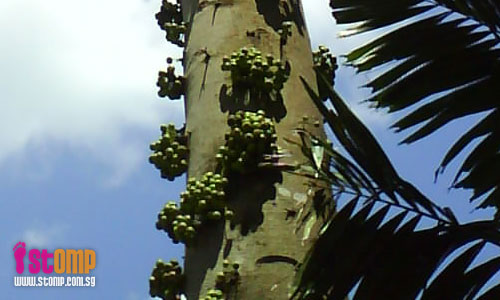
Responding to STOMP's query, NParks has identified the tree to be a fig tree, and advise against eating the fruits.
According to NParks:
"Based on the pictures, the tree could either be a Ficus fistulosa (Common Yellow-Stemmed Fig) or Ficus variegata (Common Red-stemmed Fig).
"The fruits of the Ficus fistulosa ripen to yellow/yellow-orange, while the fruits of the Ficus variegata ripen to red. Both belong to the fig family.
"We advise against eating the fruits."
Related story:
What a weird, weird tree

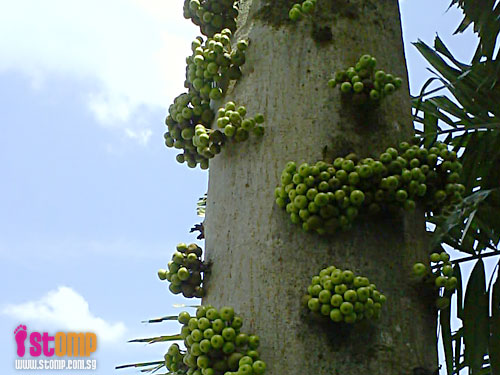
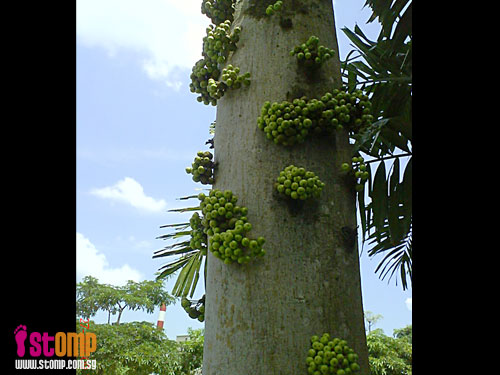
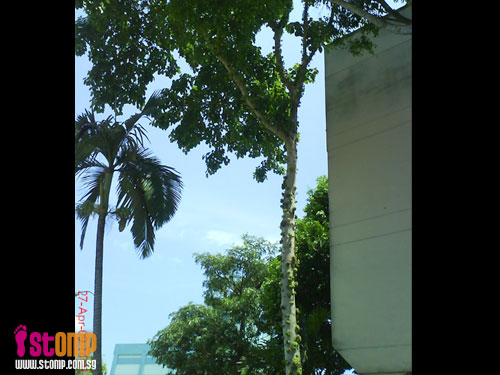


Related post: What a weird, weird tree (28th April 2009)
I've finally managed to get a copy of A Guide To The Fabulous Figs Of Singapore, and yes indeed, the fig trees in the photos above are either the common yellow stem-fig (Ficus fistulosa) or common red stem-fig (F. variegata). In this post, I will refer to the common yellow stem-fig as fistulosa and the common red stem-fig as variegata.

Common yellow stem-fig;
The main difference between the 2 species is that fistulosa lacks the buttress roots seen in variegata. Also, while the figs of fistulosa ripen to a bright yellow, those of variegata turn bright red when ripe.
Here's what A Guide To The Fabulous Figs Of Singapore has to say about fistulosa:
Ficus fistulosa 黄柄榕 Common Yellow Stem-fig
This tree may reach a maximum height of about 12m. It is possibly the most common forest fig in Singapore and one of two local fig species with figs growing on its main trunk. They can be observed growing in open forests, hedges and along forest fringes.
Its young twigs are hollow and may have short dark brown hair. Its large leathery dark green leaves are elliptical or slightly obovate, varying in length from 13 to 25 cm. Young leaves are an attractive apricot-pink.
Figs vary from round to pear-shaped, and are slightly rough on the surface. They grow to about 2.5 cm wide, with short necks attached to long stalks 2-4 cm in length. They occur on trunks and stems, a condition known as 'cauliflory' (see F. variegata). Figs ripen to a bright yellow hence this tree is called 'Yellow Stem-fig'.
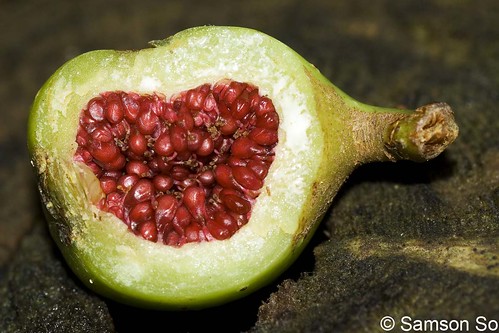
Common yellow stem-fig;
(Photo by Samson So Photography)
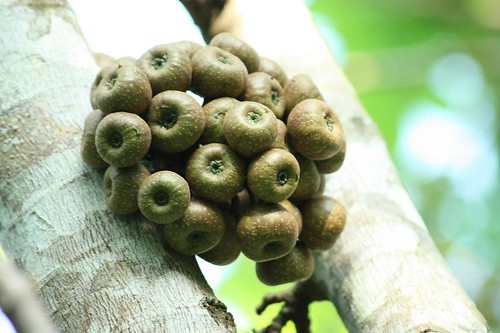
Common red stem-fig;
(Photo by yiegp)
And here's the entry on variegata:
Ficus variegata 青果榕 Common Red Stem-fig
Common in forest margins and urban parks, a figging F. variegata is an awesome sight - a huge tree whose trunk and branches are laden with dense clusters of green or red figs. This deciduous tree grows up to 30 m and has spreading buttresses. Its bark is smooth, bearing short stumpy black twigs from which grow each new crop of figs.
The leathery leaves of F. variegata are ovate in shape, and vary in length from 9-20 cm. They have long stalks, entire margins and pointed tips. Leaf bases are prominently tri-nerved. Saplings tend to have larger leaves with toothed margins.
Its cauliflorous figs are round or apple-shaped, up to 3.8 cm wide, short-necked and long-stalked. They are green and turn rose-red when ripe. Only trees of more than 5 m tall have been observed to bear figs.
A smaller tree, F. fistulosa, the Common Yellow Stem-fig, which is also cauliflorous, is often mistaken for a young F. variegata, but it has not buttress roots.

Common red stem-fig;
(Photo by mingiweng)
Figs are an extremely diverse and variable group; here in Singapore, we have figs that grow as climbers, creeping up tree trunks and walls. Others are more 'normal'-looking shrubs and trees, while the majority of fig species found locally are stranglers, a group that includes those known as banyans.
The book doesn't say if the figs of fistulosa or variegata are suitable for human consumption or not, although 2 exotic species, the creeping fig (F. pumila) and broad-leafed fig (F. auriculata), are said to bear edible figs. The figs sold in our supermarkets belong to the common fig (F. carica), a species native to the eastern Mediterranean and southwest Asia, and not found locally.
Figs are very important components of forest ecosystems, as they support a wide variety of frugivorous animals. Large numbers of birds may converge upon a single tree to feast upon the figs, from bulbuls to hornbills. Even insectivorous birds join in, drawn by the insects that are inevitably attracted to the masses of ripening fruit. The birds are often joined by primates such as macaques, gibbons and orangutans, as well as smaller mammals such as squirrels and tree shrews, while fruit bats and civets eat their fill under the cover of darkness. On the ground, pheasants, pigs, deer and sun bear gorge themselves on the fallen fruit. Hence, a single tree may provide food for a large variety of forest creatures, as well as all the other species which do not directly feed upon the figs, but depend on the fig-eaters in one way or another. And because figs do not synchronise their fruiting periods, they provide a year-round supply of food, an especially vital resource for frugivores when other trees might not be bearing fruit at all. Figs can be considered to be keystone species, and the loss of a single fig tree can have serious consequences for all the fruit-eating creatures in a patch of forest.
The Bird Ecology Study Group has quite a number of posts documenting the importance of figs in the diets of many local bird species.
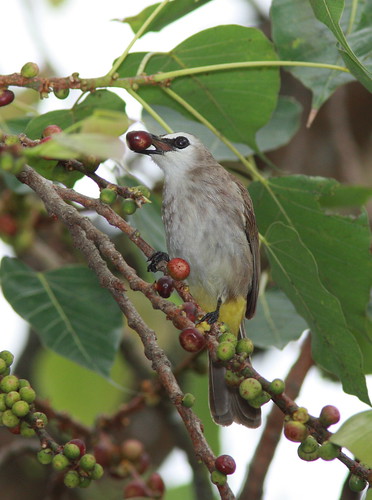
Yellow-vented bulbul (Pycnonotus goiavier) feeding on sacred fig (Ficus religiosa), Chinese Garden;
(Photo by *Damselfly*)

Great hornbill (Buceros bicornis) feeding on sea fig (Ficus superba), Singapore Botanic Gardens;
(Photo by Lip Kee)
I wish I could talk more about strangler figs, and how figs are pollinated, but I'll have to stop here for now. If you're interested in knowing more about local figs, there is no better resource than A Guide To The Fabulous Figs Of Singapore.